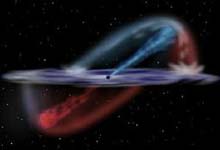Gemini Observatory Probes Galaxy’s Churning Core

Image: Jon Lomberg
Astronomers using the Gemini North Telescope on Hawaii’s Mauna Kea report that they have created a three-dimensional movie of a powerful, active galaxy located some 70 million light years away. The addition of a new instrument, the Integral Field Unit (IFU), to the Gemini telescope enabled the group to study light from the galaxy NGC1068 in much greater detail. From a single still of NGC1068, the IFU generated data on the physical conditions and velocities of galactic material throughout the image. This information, in turn, allowed the astronomers to create an animated picture that provides a fresh look at the workings of the galaxy, including an enormous pair of jets bursting out of a suspected black hole at its core. Two reports on these findings will appear in the Conference Series of the Astronomical Society of the Pacific.
The benefit of using the advanced Gemini telescope, the scientists say, stems from its capacity for capturing and refining light. In this case, the IFU transmits the enormous volume of light collected by Gemini through hundreds of tiny optical fibers, each of which bears a micro-lens at its tip. The optical fibers send the light to an advanced spectrograph, which produces a single spectrum for each fiber–1500 in all. From that data, the researchers can describe and track the motions of gas or stars at any point in the image. “When we play back our movie of the galaxy NGC1068, we see a three-dimensional view of the core,” says Bryan Miller, the Gemini instrument scientist for IFUs. Of particular interest are the two jets that extend out from the galaxy’s center. Gemini scientist Jean-Rene Roy compares the shockwave-type effect the enormous jets inflict on the galaxy’s surrounding gaseous disk to that of “a huge wave smashing onto a galactic shoreline.”
More advanced IFUs may provide better images still. Within the next two years, for instance, new optical and near-infrared IFUs will be used on both Gemini North and a sister telescope in Chile. These new systems should produce some of the highest resolution images obtainable by telescopes, enabling astronomers to study in even closer detail the dynamics of distant galaxies.
Media Contact
More Information:
http://www.gemini.edu/media/IFUImages.htmlAll latest news from the category: Physics and Astronomy
This area deals with the fundamental laws and building blocks of nature and how they interact, the properties and the behavior of matter, and research into space and time and their structures.
innovations-report provides in-depth reports and articles on subjects such as astrophysics, laser technologies, nuclear, quantum, particle and solid-state physics, nanotechnologies, planetary research and findings (Mars, Venus) and developments related to the Hubble Telescope.
Newest articles

First-of-its-kind study uses remote sensing to monitor plastic debris in rivers and lakes
Remote sensing creates a cost-effective solution to monitoring plastic pollution. A first-of-its-kind study from researchers at the University of Minnesota Twin Cities shows how remote sensing can help monitor and…

Laser-based artificial neuron mimics nerve cell functions at lightning speed
With a processing speed a billion times faster than nature, chip-based laser neuron could help advance AI tasks such as pattern recognition and sequence prediction. Researchers have developed a laser-based…

Optimising the processing of plastic waste
Just one look in the yellow bin reveals a colourful jumble of different types of plastic. However, the purer and more uniform plastic waste is, the easier it is to…


